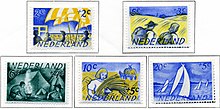Paul Citroen
Paul Citroen | |
|---|---|
 Paul Citroen | |
| Born | 15 December 1896 |
| Died | 13 March 1983 (aged 86) |
| Nationality | Dutch |
| Notable work | Metropolis, postage stamps |
Roelof Paul Citroen (15 December 1896 – 13 March 1983) was a German-born Dutch artist, art educator and co-founder of the New Art Academy in Amsterdam. Among his best-known works are the photo-montage Metropolis and the 1949 Dutch postage stamps.
Biography
Early life
Citroen was born and grew up in a middle-class family in Berlin. Both his parents were Dutch Jews.[1] His father owned a fur shop. At an early age, Citroen began drawing, provoking strong support from his parents. He soon started to experiment with photography with Erwin Blumenfeld and studied art in Berlin.
As a painter, he was a Dadaist. As a visual artist in photography, he used the Bauhaus Style of physical portraits, many times with the subject peering intensely into the camera.[2]


In 1919 Citroen began studying at the Bauhaus, where he started taking lessons from Paul Klee and Wassily Kandinsky (part of Der Blaue Reiter) and Johannes Itten, who became one of his biggest influences. Around this time, he started Metropolis (1923), which became his best-known piece. Citroen's Metropolis influenced Fritz Lang to make his classic film Metropolis. Between 1929 and 1935, Citroen made many photographs, clearly influenced by his work with Blumenfeld.
Citroen's work was included in the 1939 exhibition and sale Onze Kunst van Heden (Our Art of Today) at the Rijksmuseum in Amsterdam.[3]
Later life
He soon started up the Nieuwe Kunstschool (New Art School) with Charles Roelofsz. It ran out of money and closed down in 1937. That year, Citroen became a scholar at the Royal Academy of Art in The Hague. Among his many students are Kees Bol,[4] Madeleine Gans,[4] Henk Hartog,[4] and Jos Zeegers.[4] He designed his monumental postage stamps in 1949. In 1960 he stopped teaching and started painting portraits as his main focus. He painted portraits of famous Dutch people, including a well-known portrait of Liesbeth List in 1979.
Paul Citroen died in 1983 in Wassenaar.
Public collections
- Gemeentemuseum Den Haag
- Hermann-Hesse-Museum, Calw
- Literatuurmuseum, Den Haag
- Museum De Fundatie, Zwolle
- Rijksmuseum Amsterdam
- Prentenkabinet Rijksuniversiteit, Leiden
- Stedelijk Museum Amsterdam
- MoMA, New York
- Metropolitan Museum of Art, New York
- Art Institute of Chicago
References
- ^ "Joods Historisch Museum - Joods Cultureel Kwartier". jck.nl.
- ^ "Charles Roelofsz, (1931) by Paul Citroen". www.artgallery.nsw.gov.au.
- ^ "Onze kunst van heden, 1939 -". Beeldend BeNeLux Elektronisch (Lexicon). Retrieved 29 December 2020.
- ^ a b c d "Discover painter, watercolorist, draftsman Paul Citroen". rkd.nl.
- Answers - The Most Trusted Place for Answering Life's Questions
- Paul Citroen (1896-1983)
- Discover painter, watercolorist, draftsman Paul Citroen
External link
![]() Media related to Paul Citroen at Wikimedia Commons
Media related to Paul Citroen at Wikimedia Commons
